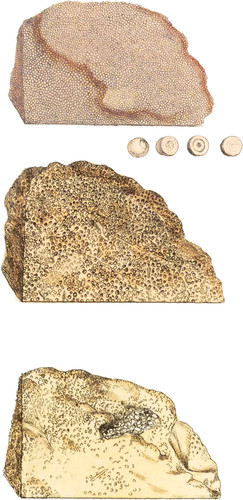 Enlarge
Enlarge
British Mineralogy
Lime Stone
- Class 2. Earth.
- Order 1. Homogeneous
- Gen. 1. Lime.
- Spec. Carbonate of Lime.
- Div. 3. Amorphous.
- Syn.
- Pierre à chaux commune. Born, v. 1. 284.
- Kalxstein. Emmerling, v. 1. 437.
- Compact limestone. Kir, v. 1. 82.
- Chaux carbonatée grossière. Haüy, v. 2. 166.
Limestone, generally speaking, is carbonate of lime, harder than chalk, often containing 10 or 12 per cent. of clay or iron. If so much as 15, Mr. Kirwan says it should be excluded, as scarcely affording good lime in burning.
Upper figure. Ketton-stone, found in abundance at Ketton in Rutlandshire. It is remarkable for its singular accretions in the form of fishes roe, whence it is often called Roe-stone. it is used for building in many places: some of the colleges at Cambridge are built with it. The same uniform appearance extends to very large masses; and although a sound, strong and durable stone in the mass, very little pieces may be crumbled to gains by the fingers. The masons use a common carpenters saw in working it: the little round particles being easily detached, it passes readily through it. They sometimes have a little dusty or solid nucleus, coated concentrically; at other times are hollow. In the next county, Northamptonshire, there is a stone called by the masons Barneck, greatly resembling this, but coarser, containing shells, &c. Col. Walford found a stone of a similar nature with larger grains (which approaches the oviform limeſtone of Kirwan, v. 1. 91), at Birdbrook, Essex, mingled with shells, which has sometimes sufficient clay or argil to be called marle.
Middle figure. Bath-stone, frequently contains the same concretions, but more decomposed, and a matrix surrounding them, somewhat confusedly crystallized, forming little hollows: many species of shells, encrini, &c. are found in it; sometimes however so comminuted as to be quite indistinct. I picked up a piece of stone at Burford in Oxfordshiare, which is of a reddish brick colour, with the hollows very distinct, giving it a volcanic or cindery appearance. With difficulty very small pieces crumble between the fingers.
Lower figure. Portland-stone, nearly like the Bath-stone. The best sort is more compact, and whiter: there are many varieties of it, paſſing into marly, flinty, &c. It often affords good crystals. The specimen figured had some little rhombs half relieved on it. A crystallization called, from its resemblance, sugar-candy spar is frequent among it. Shells of various kinds are often found in it. Sometimes it appears in the form of large trunks of trees, hardest within, resembling whitish chert.
- Ketton-stone, colour light reddiſh brown, lustre 0.
- Transparency 0.
- Fracture earthy granular.
- Hardness 5 or 6.
It contains 90 per cent. calx, and 10 of argil. The Bath and Portland nearly the same in most respects, but harder.
Spec. grav. Kir. v. 1. 88.
- Kettin 2.456
- Bath 2.494
- Portland 2.461

